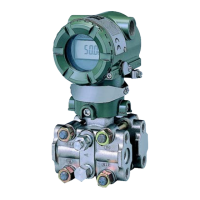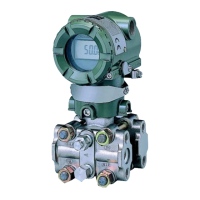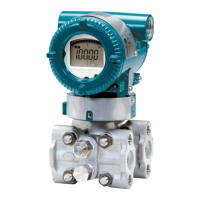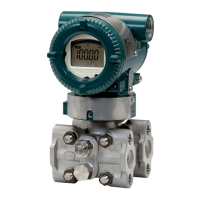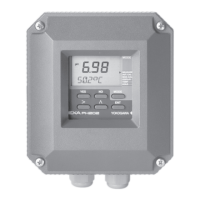<2. Handling Cautions>
13
IM01C25A01-01E
Note3. Operation
• Keepthe“WARNING”nameplateattachedtothe
transmitter.
WARNING:OPENCIRCUITBEFORE
REMOVINGCOVER.FACTORYSEALED,
CONDUITSEALNOTREQUIRED.INSTALLIN
ACCORDANCEWITHTHEUSERSMANUALIM
01C25.
• Takecarenottogeneratemechanicalsparking
whenaccessingtotheinstrumentandperipheral
devicesinahazardouslocation.
Note4. MaintenanceandRepair
• Theinstrumentmodicationorpartsreplacement
byotherthanauthorizedrepresentativeof
YokogawaElectricCorporationisprohibitedand
willvoidFactoryMutualExplosionproofApproval.
e. FM Intrinsically Safe and Explosion Proof
Combination for HART/BRAIN Protocol
Type
EJX/EJA-ESeriespressuretransmitterswith
optionalcode/FU1or/V1U1canbeselectedthe
typeofprotection(FMIntrinsicallySafeorFM
Explosionproof)foruseinhazardouslocations.
Note1. Fortheinstallationofthistransmitter,oncea
particulartypeofprotectionisselected,any
othertypeofprotectioncannotbeused.The
installationmustbeinaccordancewiththe
descriptionaboutthetypeofprotectioninthis
instruction manual.
Note2. Inordertoavoidconfusion,unnecessary
markingiscrossedoutonthelabelother
thantheselectedtypeofprotectionwhenthe
transmitter is installed.
2.4.2 CSACertication
a. CSA Intrinsically Safe for HART/BRAIN
Protocol Type (Except for EJX90A)
CautionforCSAIntrinsicallysafeandnonincendive
type.(Followingcontentsreferto“DOCNo.ICS013-
A13”)
Note1. EJX/EJA-ESeriespressuretransmitterswith
optionalcode/CS1areapplicableforusein
hazardouslocations.
Certicate:1606623
[ForCSAC22.2]
• ApplicableStandard:C22.2No.0,C22.2No.0.4,
C22.2No.25,C22.2No.94,C22.2No.157,
C22.2No.213,C22.2No.60079-0,
C22.2No.61010-1,C22.2No.61010-2-030
• IntrinsicallySafeforClassI,Division1,Groups
A,B,C&D,ClassII,Division1,GroupsE,F&G,
ClassIII,Division1
• NonincendiveforClassI,Division2,GroupsA,B,
C&D,ClassII,Division2,GroupsF&G,ClassIII,
Division 1
• Enclosure:Type4X
• Temp.Code:T4
• Amb.Temp.:–50*to60°C
*–15°Cwhen/HEisspecied.
• ProcessTemperature:120°Cmax.
[ForCSAE60079]
• ApplicableStandard:CAN/CSAE60079-11,
CAN/CSAE60079-15,IEC60529:2001
• ExiaIICT4,ExnLIICT4
• AmbientTemperature:–50to60°C
• Max.ProcessTemp.:120°C
• Enclosure:IP66/IP67
Note2. EntityParameters
• Intrinsicallysaferatingsareasfollows:
MaximumInputVoltage(Vmax/Ui)=30V
MaximumInputCurrent(Imax/Ii)=200mA
MaximumInputPower(Pmax/Pi)=0.9W
MaximumInternalCapacitance(Ci)=10nF
MaximumInternalInductance(Li)=0µH
• Type"n"orNonincendiveratingsareasfollows:
MaximumInputVoltage(Vmax/Ui)=30V
MaximumInternalCapacitance(Ci)=10nF
MaximumInternalInductance(Li)=0µH
• InstallationRequirements
Uo≤Ui,Io≤Ii,Po≤Pi,
Co≥Ci+Ccable,Lo≥Li+Lcable
Voc≤Vmax,Isc≤Imax,
Ca≥Ci+Ccable,La≥Li+Lcable
Uo,Io,Po,Co,Lo,Voc,Isc,CaandLaare
parametersofbarrier.
Note3. Installation
• Inanysafetybarreirusedoutputcurrentmust
belimitedbyaresistor'R'suchthatIo=Uo/Ror
Isc=Voc/R.
• ThesafetybarriermustbeCSAcertied.
• Inputvoltageofthesafetybarriermustbeless
than250Vrms/Vdc.
• InstallationshouldbeinaccordancewithCanadian
ElectricalCodePartIandLocalElectricalCode.
• Dust-tightconduitsealmustbeusedwhen
installedinClassIIandIIIenvironments.
• Theinstrumentmodicationorpartsreplacement
byotherthanauthorizedrepresentativeof
YokogawaElectricCorporationandYokogawa
CorporationofAmericaisprohibitedandwill
voidCanadianStandardsIntrinsicallysafeand
nonincendiveCertication.
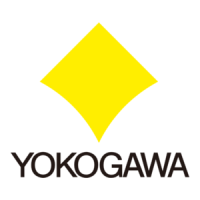
